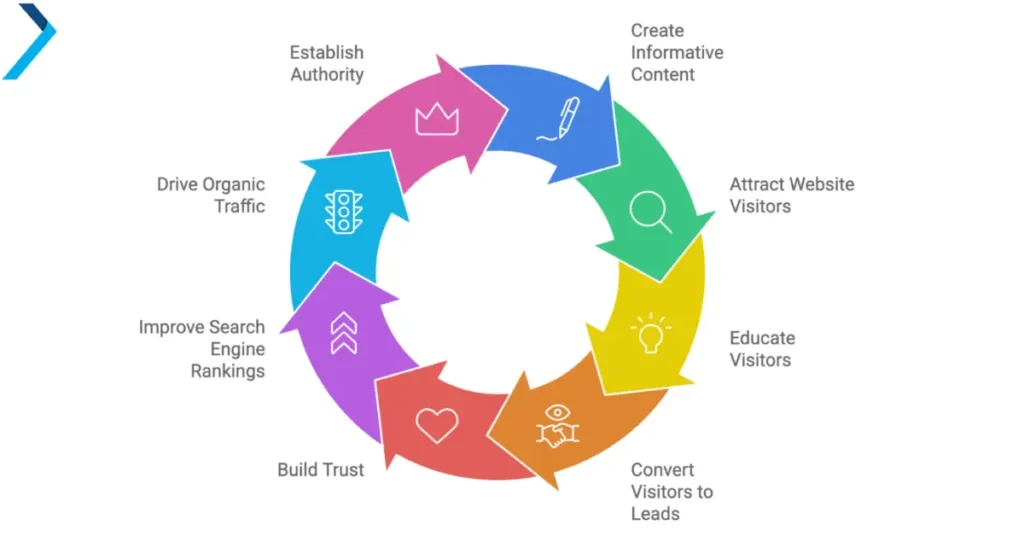- Get Your Free Digital Marketing Audit Today! 🚀 Let's Boost Your Online Presence Together! 💡
- +1 (647) 995-1577
- info@flexforce.pro
Jewelry Content Marketing Strategies to Grow Your Business
Jewelry content marketing refers to the strategic creation and distribution of valuable, visually engaging, and emotionally resonant content designed to attract, engage, and convert potential customers within the jewelry industry. According to the Content Marketing Institute, 72% of marketers say content marketing increases engagement and leads, especially in high-touch sectors like luxury retail. This makes content marketing an indispensable tool for jewelry brands aiming to build brand authority, customer trust, and long-term loyalty.
There are multiple forms of jewelry content marketing, including storytelling-driven blog posts, influencer collaborations, user-generated content campaigns, interactive visual guides, and SEO-optimized product descriptions. As luxury branding expert Sarah J. Parker explains, “Jewelry buyers connect emotionally with the stories behind pieces. Content that brings those stories to life can convert browsers into lifelong brand advocates.”
High-impact content marketing jewelry strategies serve not only to amplify brand visibility but also to create a cohesive narrative that supports purchase decisions in a visually driven market. The effectiveness of such strategies is measured through KPIs like engagement rates, organic traffic, conversion metrics, and social shares. To maximize efficiency, jewelry marketers should align content with customer personas, invest in high-quality visuals, and ensure consistency across platforms. This article offers a detailed guide to actionable content marketing techniques tailored to the unique aesthetics and buyer psychology of the jewelry sector.
What is Content Marketing?

With the goal to draw in and hold on to a sure audience, content marketing is an effective technique that centres on creating and distributing timely, pertinent, and consistent information.
If jewelry makers want to engage with potential customers, they may need to create interesting blog entries, attractive social media content, educational films, and more.
Why Content Marketing Matters for Jewelers
Content marketing helps companies to present their products in more approachable ways in the jewelry industry, where beauty and emotional connection are important factors in buyer choices.
It enables jewelry producers to share the history of their designs, highlighting the artistry, sources of motivation, and unique selling points that identify them from competition. Explore more about comprehensive jewelry branding services to position your brand effectively.
Understanding Your Audience
Before creating content, identify your ideal customers. Are they:
- Luxury buyers looking for high-end, exclusive pieces?
- Young couples shopping for engagement rings?
- Fashion-conscious buyers seeking trendy, affordable jewelry?
Using tools like Google Analytics and social media insights, segment your audience based on demographics, interests, and purchasing behavior. This informs content themes, tone, platform selection, and supports the development of practical jewelry marketing ideas tailored to different customer groups.
Understanding Content Marketing for Jewelry

With the objective to draw in and hold on to a specific audience, jewelry content marketing focuses on creating and distributing useful, timely, and consistent information.
The approach promotes relationship-building by using stories and educational content to speak to the needs and interests of potential clients.
Understanding Content Marketing in the Jewelry Industry
A thorough understanding of your target market is necessary for jewelry content marketing success.
Initially, create buyer personas that represent various audience segments so that you can adjust your messaging correctly and generate better content ideas for jewelry business blogs, videos, and ads. The core of your content should be authentic stories, a key principle in jewellery content writing, because it helps establish an emotional connection between the brand and the consumer.
Keyword Research Based on Consumer Intent
An essential step in creating content that resonates with your audience is conducting keyword research that reflects their search intent. Learn SEO tips for jewelry businesses to help align your content with the keywords your audience is actively using.
- Informational Intent: Keywords like “how to choose the right engagement ring” or “best metals for jewelry” target users seeking guidance and insights.
- Transactional Intent: Phrases such as “buy gold necklace online” or “custom diamond earrings near me” are aimed at ready-to-purchase audiences.
- Navigational Intent: Use branded terms like “XYZ Jewelers store locations” to help customers find specific information about your business.
Incorporating these insights into your strategy ensures your content is visible to the right audience, improving engagement and driving conversions.
Learn how to choose the Best SEO Keywords for Jewelers to effectively target your audience and boost your online presence.
Creating a Strong Brand Identity
In order to stand out in a field that is becoming more and more productive, jewelry store content marketing requires developing a strong brand identity.
Develop the fundamental principles of your business first, then the USPs (unique selling points) that best capture the heart of your jewelry collections. To build a unified brand image, use these components regularly across all content platforms or compile them into a comprehensive jewelry content marketing PDF to guide your team.
Utilizing Diverse Content Formats
Businesses need to use a range of content kinds if you want to engage clients and keep your material fresh.
Jewelry shops can utilise posts on blogs to offer helpful information like how to maintain diamonds or how jewelry is made. Using high-quality photos and videos, you may promote the more beautiful features of your products on social media platforms like Instagram.
Measuring and Optimising Content Performance
Understanding what appeals to your audience and where you may make improvements calls for assessing the performance of your content. Analyse metrics like conversion rates, rates of clicks, and levels of engagement with analytics tools.
Jewelry shops may optimise their jewelry content marketing strategy by getting insights into audience preferences through the analysis of these metrics.
Creating a Content Strategy for Jewelry Brands

Defining Your Target Audience
Understanding that your target audience is important before you start producing any content. Jewelry manufacturers should customise material based on factors including age, gender, interests, purchasing patterns, and economic status.
Knowing your target makes it easier to create customised material that appeals to the wants and needs of potential customers—or consider guest contributions if you’re looking to write for us jewellery publications for added exposure.
Setting Clear Objectives
Possessing well-defined goals is essential to a successful content strategy.
If the objective is to boost sales, lead generation, or awareness of the brand, a targeted approach directs content efforts and makes it possible to quantify results precisely—making it a vital part of any successful marketing plan.
Effective Content Types for Jewelry Brands
Different content formats serve various purposes. Here are proven types that drive engagement and conversions:
Blog Posts and Articles
You may build your brand as an authority in the industry by writing comprehensive blog entries and articles about jewelry trends, care advice, or the background of the stones you sell.
By educating your audience, this type of material enhances your website’s search engine optimization (SEO), which makes it simpler for potential clients finds you online.
Visual Content: Photos and Videos
Jewellery is aesthetically pleasing by nature, and marketing campaigns can be significantly enhanced by showing breathtaking images and videos.
Stunning photos of your jewelry, behind-the-scenes videos, or engaging jewelry ads can draw in potential customers and give them a better understanding of what makes your products unique.
Leveraging Social Media for Jewelry Brands
Choosing the Right Platforms
Finding the right avenues is essential, as various social media platforms have different features.
A couple of visual-focused platforms that are perfect for jewelry producers to present their beautiful items and communicate with the public include Instagram and Pinterest.
Engaging Audiences
It is important to create social media content that attracts followers and promotes engagement.
Organising competitions, working with bloggers, using live streaming, or implementing creative digital marketing ideas can improve interaction and build a brand community.
Measuring Content Marketing Success
Key Performance Indicators (KPIs)
In order to evaluate the success of your content promotion activities, you must identify and monitor key performance metrics, or KPIs, such as website traffic, social media interaction and lead generation.
Regular evaluation of these indicators enables plan modifications and improvements.
Analysing Customer Feedback
Customer reviews provide valuable insight on how well your content marketing is working.
To better understand customer tastes and enhance content outputs, promote reviews and employ surveys.
Case Study: Real Results from Effective Jewelry Content Marketing
The power of well-executed content marketing is clearly demonstrated by recent successes in the jewelry industry. For example, the team of Flexforce PRO was able to increase organic traffic by 35%, with the number of new organic users growing by 25% to reach 23,000 compared to the previous year. This growth translated into a 28% increase in organic transactions and a 24% rise in organic revenue. Additionally, email campaign conversion rates saw significant improvements: revenue from automated email campaigns increased by 12%, revenue per recipient rose by 15%, click rates climbed by 67%, and campaign open rates surged by 89%. You can learn more about this success with the Siegel Jewelers SEO case study.
In another case, Flexforce PRO helped increase total site revenue by 24% in just one year, with organic revenue jumping by nearly 40%. Paid social media campaigns performed exceptionally well, generating over fourteen times the ad spend in revenue and achieving an impressive return on investment. Find out more about this campaign in the Ideal Luxury SEO case study.
These results highlight how a strategic content marketing approach tailored to the jewelry sector can drive meaningful growth in both traffic and sales.
Conclusion
Once executed properly, jewelry content marketing may greatly improve a brand’s standing in the marketplace.
Jewelry brands can create lasting connections with clients and drive business success by knowing their target audience, producing a variety of content, and using platforms that are right for them.
Keeping success in the constantly changing digital marketplace requires constant analysis and change, just like in any other marketing attempt.
FAQS
What is jewelry content marketing?
If one wants to draw in and keep a target audience interested while promoting a jewelry business, jewelry content marketing involves creating and distributing useful, timely, and consistent content.
With the goal of increasing awareness of the brand, trust, and hopefully sales, this can involve telling stories, images, social media management, blogging, and more.
How can storytelling benefit my jewelry brand?
In discussing the ideas behind your designs, the journey of your materials, or the history of your business, you can use story to emotionally connect with your audience.
This intimate relationship can increase customer engagement and brand loyalty, elevating your products from mere objects to elements of a larger story.
Why is visual content important for jewelry marketing?
When it highlights the fine details, colours, and workmanship of jewelry pieces all of which are frequently major selling points—visual content is essential.
The elegance and beauty of the products can be captured in high-quality photos and films, which will draw in potential buyers and increase the probability of buying.
Which social media platforms are best for jewelry brands?
As Instagram and Pinterest are visual platforms, they work especially well for jewelry brands.
Pinterest can provide creativity through theme boards and pins, targeting people who are actively looking for jewelry ideas, while Instagram allows customers to interact directly with posts, stories, and reels.
How does blogging improve my jewelry brand’s visibility?
As providing chances to include search engine optimization (SEO) methods, blogging increases accessibility.
In producing interesting and educational blog posts that provide jewelry-related answers or knowledge, you may increase the frequency with which your brand is shown in search results, pulling in organic visitors and building industry authority.
What metrics should I track to measure content marketing success?
Website traffic, social media participation, time spent on your site, conversion rates, and customer feedback are important metrics to monitor.
Through the use of technologies such as Google Analytics or help from a marketing agency, you may better assess the performance of your material and make the necessary changes to improve methods and results.



